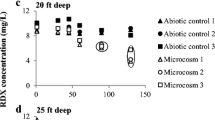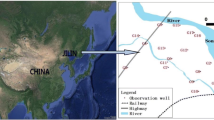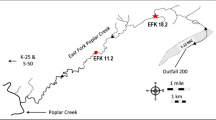Abstract
The contamination of groundwater with mercury (Hg) is an increasing problem worldwide. Yet, little is known about the interactions of Hg with microorganisms and their processes in subsurface environments. We tested the impact of Hg on denitrification in nitrate reducing enrichment cultures derived from subsurface sediments from the Oak Ridge Integrated Field Research Challenge site, where nitrate is a major contaminant and where bioremediation efforts are in progress. We observed an inverse relationship between Hg concentrations and onset and rates of denitrification in nitrate enrichment cultures containing between 53 and 1.1 μM of inorganic Hg; higher Hg concentrations increasingly extended the time to onset of denitrification and inhibited denitrification rates. Microbial community complexity, as indicated by terminal restriction fragment length polymorphism (tRFLP) analysis of the 16S rRNA genes, declined with increasing Hg concentrations; at the 312 nM Hg treatment, a single tRFLP peak was detected representing a culture of Bradyrhizobium sp. that possessed the merA gene indicating a potential for Hg reduction. A culture identified as Bradyrhizobium sp. strain FRC01 with an identical 16S rRNA sequence to that of the enriched peak in the tRFLP patterns, reduced Hg(II) to Hg(0) and carried merA whose amino acid sequence has 97 % identity to merA from the Proteobacteria and Firmicutes. This study demonstrates that in subsurface sediment incubations, Hg may inhibit denitrification and that inhibition may be alleviated when Hg resistant denitrifying Bradyrhizobium spp. detoxify Hg by its reduction to the volatile elemental form.




Similar content being viewed by others
References
Allard B, Arsenie I (1991) Abiotic reduction of mercury by humic substances in aquatic system—an important process for the mercury cycle. Water Air Soil Pollut 56:457–464
Atlas RM (2004) Handbook of microbiological media, 3rd edn. CRC Press, New York
Barkay T (1987) Adaptation of aquatic microbial communities to Hg2+ Stress. Appl Environ Microbiol 53:2725–2732
Barkay T, Wagner-Dobler I (2005) Microbial transformations of mercury: potentials, challenges, and achievements in controlling mercury toxicity in the environment. Adv Appl Microbiol 57:1–52
Barkay T, Miller SM, Summers AO (2003) Bacterial mercury resistance from atoms to ecosystems. FEMS Microbiol Rev 27:355–384
Barkay T, Kritee K, Boyd E, Geesey G (2010) A thermophilic bacterial origin and subsequent constraints by redox, light and salinity on the evolution of the microbial mercuric reductase. Environ Microbiol 12:2904–2917
Barringer JL, Szabo Z (2006) Overview of investigations into mercury in ground water, soils, and septage, new jersey coastal plain. Water Air Soil Pollut 175:193–221
Barringer JL, MacLeod CL, Gallagher RA (1997a) Mercury in ground water, soils, and sediments of the Kirkwood–Cohansey aquifer system in the New Jersey coastal plain. US Geological Survey Open-File Report, 95-475
Barringer JL, MacLeod CL, Gallagher RA (1997b) Relation of mercury to other chemical constituents in ground water in the Kirkwood–Cohansey aquifer system in the New Jersey Coastal Plain. US Geological Survey Open-File Report, 95-475
Barringer JL, Szabo Z, Kauffman LJ, Barringer TH, Stackelberg PE, Ivahnenko T, Rajagopalan S, Krabbenhoft DP (2005) Mercury concentrations in water from an unconfined aquifer system, New Jersey coastal plain. Sci Total Environ 346:169–183
Behrendt U, Schumann P, Stieglmeier M, Pukall R, Augustin J, Spröer C, Schwendner P, Moissl-Eichinger C, Ulrich A (2010) Characterization of heterotrophic nitrifying bacteria with respiratory ammonification and denitrification activity—Description of Paenibacillus uliginis sp. nov., an inhabitant of fen peat soil and Paenibacillus purispatii sp. nov., isolated from a spacecraft assembly clean room. Syst Appl Microbiol 33:328–336
Beman MJ, Arrigo KR, Matson PA (2005) Agricultural runoff fuels large phytoplankton blooms in vulnerable areas of the ocean. Nature 434:211–214
Black FJ, Paytan A, Knee KL, de Sieyes NR, Ganguli PM, Gray E, Flegal AR (2009) Submarine groundwater discharge of total mercury and monomethylmercury to central california coastal waters. Environ Sci Technol 43:5652–5659
Bollen A, Wenke A, Biester H (2008) Mercury speciation analyses in HgCl2-contaminated soils and groundwater—Implications for risk assessment and remediation strategies. Water Res 42:91–100
Bone SE, Charette MA, Lamborg CH, Gonneea ME (2007) Has submarine groundwater discharge been overlooked as a source of mercury to coastal waters? Environ Sci Technol 41:3090–3095
Bowen JL, Kroeger KD, Tomasky G, Pabich WJ, Cole ML, Carmichael RH, Valiela I (2007) A review of land-sea coupling by groundwater discharge of nitrogen to New England estuaries: mechanisms and effects. Appl Geochem 22:175–191
Brooks SC (2001) Waste characteristics of the former S-3 ponds and outline of uranium chemistry relevant to NABIR field research center studies. ORNL/TM-2001/27
Brooks SC, Southworth GR (2011) History of mercury use and environmental contamination at the Oak Ridge Y-12 Plant. Environ Pollut 159:219–228
Chatziefthimiou A, Crespo-Medina M, Wang Y, Vetriani C, Barkay T (2007) The isolation and initial characterization of mercury resistant chemolithotrophic thermophilic bacteria from mercury rich geothermal springs. Extremophiles 11:469–479
Coombs JM, Barkay T (2004) Molecular evidence for the evolution of metal homeostasis genes by lateral gene transfer in Bacteria from the deep terrestrial subsurface. Appl Environ Microbiol 70:1698–1707
De Lipthay JR, Rasmussen LD, Oregaard G, Simonsen K, Bahl MI, Kroer N, Sørensen SJ (2008) Acclimation of subsurface microbial communities to mercury. FEMS Microbiol Ecol 65:145–155
Driese SG (2002) Report on petrographic and geochemical characterization of Nolichucky Shale saprolite, cores FB300 and FB301, NABIR Field Site, Oak Ridge Reservation, NABIR FRC. Technical Report
Edwards L, Kusel K, Drake H, Kostka JE (2007) Electron flow in acidic subsurface sediments co-contaminated with nitrate and uranium. Geochim Cosmochim Acta 71:643–654
Farrel RE, Germida JJ, MH P (1993) Effects of chemical speciation in growth media on the toxicity of mercury(II). Appl Environ Microbiol 59:1507–1514
Felske A, Fehr W, Pauling B, von Canstein H, Wagner-Dobler I (2003) Functional profiling of mercuric reductase (mer A) genes in biofilm communities of a technical scale biocatalyzer. BMC Microbiol 3:1–11
Fernandez L, Perotti E, Sagardoy M, Gomez M (2008) Denitrification activity of Bradyrhizobium sp. isolated from Argentine soybean cultivated soils. World J Microbiol Biotechnol 24:2577–2585
Finneran KT, Housewright ME, Lovley DR (2002) Multiple influences of nitrate on uranium solubility during bioremediation of uranium-contaminated subsurface sediments. Environ Microbiol 4:510–516
Gans J, Wolinsky M, Dunbar J (2005) Computational improvements reveal great bacterial diversity and high metal toxicity in soil. Science 309:1387–1390
Graham RI, Zahner V, Lucarotti CJ (2008) An intracellular symbiont and other microbiota associated with field-collected populations of sawflies (Hymenoptera: Symphyta). Can J Microbiol 54:758–768
Grassi S, Netti R (2000) Sea water intrusion and mercury pollution of some coastal aquifers in the province of Grosseto (Southern Tuscany, Italy). J Hydrol 237:198–211
Grigal DT, Nord WS (1983) Investigations of heavy metals in Minnesota peat lands. Report to the Minnesota Department of Natural Resources, Division of Minerals
Hurt RA, Qiu X, Wu L, Roh Y, Palumbo AV, Tiedje JM, Zhou J (2001) Simultaneous recovery of RNA and DNA from soils and sediments. Appl Environ Microbiol 67:4495–4503
Hwang C, Wu W, Gentry TJ, Carley J, Corbin GA, Carroll SL, Watson DB, Jardine PM, Zhou J, Criddle CS, Fields MW (2008) Bacterial community succession during in situ uranium bioremediation: spatial similarities along controlled flow paths. ISME J 3:47–64
Inwood SE, Tank JL, Bernot MJ (2005) Patterns of denitrification associated with land use in 9 midwestern headwater streams. J North Am Benthol Soc 24:227–245
Istok JD, Senko JM, Krumholz LR, Watson DB, Bogle MA, Peacock A, Chang YJ, White DC (2004) In situ bioreduction of technetium and uranium in a nitrate-contaminated aquifer. Environ Sci Technol 38:468–475
Kim B-Y, Weon H-Y, Yoo S-H, Lee S-Y, Kwon S-W, Go S-J, Stackebrandt E (2006) Variovorax soli sp. nov., isolated from greenhouse soil. Int J Syst Evol Microbiol 56:2899–2901
Lane DJ (1991) 16S/23S rRNA sequencing. Wiley, New York
Laurier FJG, Cossa D, Beucher C, Brévière E (2007) The impact of groundwater discharges on mercury partitioning, speciation and bioavailability to mussels in a coastal zone. Mar Chem 104:143–155
Lloyd JR, Renshaw JC (2005) Bioremediation of radioactive waste: radionuclide-microbe interactions in laboratory and field-scale studies. Curr Opin Biotechnol 16:254–260
Maier RM, Pepper IL, Gerba CP (2009) Environmental Microbiology, 2nd edn. Academic press, San Diego, p 598
Martinez RJ, Wang Y, Raimondo MA, Coombs JM, Barkay T, Sobecky PA (2006) Horizontal gene transfer of PIB-Type ATPases among Bacteria isolated from radionuclide- and metal-contaminated subsurface soils. Appl Environ Microbiol 72:3111–3118
McGuinness LM, Salganik M, Vega L, Pickering KD, Kerkhof LJ (2005) Replicability of bacterial communities in denitrifying bioreactors as measured by PCR/T-RFLP analysis. Environ Sci Technol 40:509–515
McMahon PB, Böhlke JK (2006) Regional patterns in the isotopic composition of natural and anthropogenic nitrate in groundwater, High Plains, USA. Environ Sci Technol 40:2965–2970
Ni Chadhain SM, Schaefer JK, Crane S, Zylstra GJ, Barkay T (2006) Analysis of mercuric reductase (merA) gene diversity in an anaerobic mercury-contaminated sediment enrichment. Environ Microbiol 8:1746–1752
Nies DH (1999) Microbial heavy-metal resistance. Appl Microbiol Biotechnol 51:730–750
Oregaard G, Sørensen SJ (2007) High diversity of bacterial mercuric reductase genes from surface and sub-surface floodplain soil (Oak Ridge, USA). ISME J 1:453–467
Pena J, Tokunaga T, Olson K, Herman D, Joyner D, Hazen T, Larsen J, Brodie E, Firestone M, Wan J Characterization of sediment and groundwater samples form NABIR field research center in Oak Ridge, Tennessee
Poulain AJ, Ni Chadhain SM, Ariya PA, Amyot M, Garcia E, Campbell PGC, Zylstra GJ, Barkay T (2007) Potential for mercury reduction by microbes in the high arctic. Appl Environ Microbiol 73:2230–2238
Protano G, Riccobono F, Sabatini G (2000) Does salt water intrusion constitute a mercury contamination risk for coastal fresh water aquifers? Environ Pollut 110:451–458
Rasmussen LD, Sørensen SJ, Turnerb RR, Barkay T (2000) Application of a mer–lux biosensor for estimating bioavailable mercury in soil. Soil Biol Biochem 32:639–646
Rasmussen LD, Zawadsky C, Binnerup SJ, Oregaard G, Sorensen SJ, Kroer N (2008) Cultivation of hard-to-culture subsurface mercury-resistant Bacteria and discovery of mew merA gene sequences. Appl Environ Microbiol 74:3795–3803
Rivett MO, Buss SR, Morgan P, Smith JWN, Bemment CD (2008) Nitrate attenuation in groundwater: a review of biogeochemical controlling processes. Water Res 42:4215–4232
Schaefer JK, Letowski J, Barkay T (2002) mer-mediated resistance and volatilization of Hg(II) under anaerobic conditions. Geomicrobiol J 19:87–102
Schaefer JK, Yagi J, Reinfelder JR, Cardona T, Ellickson KM, Tel-Or S, Barkay T (2004) Role of the bacterial organomercury lyase (MerB) in controlling methylmercury accumulation in mercury-contaminated natural waters. Environ Sci Technol 38:4304–4311
Senko JM, Istok JD, Suflita JM, Krumholz LR (2002) In situ evidence for uranium immobilization and remobilization. Environ Sci Technol 36:1491–1496
Shaw SA, Al TA, MacQuarrie KTB (2006) Mercury mobility in unsaturated gold mine tailings, Murray Brook mine, New Brunswick, Canada. Appl Geochem 21:1986–1998
Simbahan J, Kurth E, Schelert J, Dillman A, Moriyama E, Jovanovich S, Blum P (2005) Community analysis of a mercury hot spring supports occurrence of domain-specific forms of mercuric reductase. Appl Environ Microbiol 71:8836–8845
Sobecky PA, Coombs JM (2009) Horizontal gene transfer in metal and radionuclide contaminated soils. Methods Mol Biol 532:455–472
Southworth GR, Turner RR, Peterson MJ, Bogle MA (1995) Form of mercury in stream fish exposed to high concentrations of dissolved inorganic mercury. Chemosphere 30:779–787
Southworth GR, Peterson MJ, Ryon MG (2000) Long-term increased bioaccumulation of mercury in largemouth bass follows reduction of waterborne selenium. Chemosphere 41:1101–1105
USDOE (1997) Report on the remedial investigation of Bear Creek Valley at the Oak Ridge Y-12 plant, Oak Ridge, Tennessee. DOE/OR/01-1455/V1&D2, Oak Ridge, TN
Vetriani C, Chew YS, Miller SM, Yagi J, Coombs J, Lutz RA, Barkay T (2005) Mercury adaptation among bacteria from a deep-sea hydrothermal vent. Appl Environ Microbiol 71:220–226
Vishnivetskaya TA, Mosher JJ, Palumbo AV, Yang ZK, Podar M, Brown SD, Brooks SC, Gu B, Southworth GR, Drake MM, Brandt CC, Elias DA (2011) Mercury and other heavy metals influence bacterial community structure in contaminated Tennessee streams. Appl Environ Microbiol 77:302–311
Wang Y, Freedman Z, Lu-Irving P, Kaletsky R, Barkay T (2009) An initial characterization of the mercury resistance (mer) system of the thermophilic bacterium Thermus thermophilus HB27. FEMS Microbiol Ecol 67:118–129
Wang Y, Boyd E, Crane S, Lu-Irving P, Krabbenhoft D, King S, Dighton J, Geesey G, Barkay T (2011) Environmental conditions constrain the distribution and diversity of archaeal merA in Yellowstone National Park, Wyoming, USA. Microb Ecol 62:739–752
Website NABIR FRC Public Database. http://public.ornl.gov/nabirfrc/frcsite3.cfm
Wiatrowski HA, Ward PM, Barkay T (2006) Novel reduction of mercury(II) by mercury-sensitive dissimilatory metal reducing bacteria. Environ Sci Technol 40:6690–6696
Wogelius RA (2005) Mercury: sources, measurements, cycles, and effects. Mineral Mag 69:1078–1079
Wu W-M, Carley J, Fienen M, Mehlhorn T, Lowe K, Nyman J, Luo J, Gentile ME, Rajan R, Wagner D, Hickey RF, Gu B, Watson D, Cirpka OA, Kitanidis PK, Jardine PM, Criddle CS (2006a) Pilot-scale in situ bioremediation of uranium in a highly contaminated aquifer. 1. conditioning of a treatment zone. Environ Sci Technol 40:3978–3985
Wu W-M, Carley J, Gentry T, Ginder-Vogel MA, Fienen M, Mehlhorn T, Yan H, Caroll S, Pace MN, Nyman J, Luo J, Gentile ME, Fields MW, Hickey RF, Gu B, Watson D, Cirpka OA, Zhou J, Fendorf S, Kitanidis PK, Jardine PM, Criddle CS (2006b) Pilot-scale in situ bioremedation of uranium in a highly contaminated aquifer. 2. Reduction of U(VI) and geochemical control of U(VI) bioavailability. Environ Sci Technol 40:3986–3995
Acknowledgments
The authors thank David Watson and the team at the Oak Ridge IFRC site for providing sediment cores. This research was supported by the Office of Science (BER), U.S. Department of Energy Grant DE-FG02-08ER64544.
Author information
Authors and Affiliations
Corresponding author
Rights and permissions
About this article
Cite this article
Wang, Y., Wiatrowski, H.A., John, R. et al. Impact of mercury on denitrification and denitrifying microbial communities in nitrate enrichments of subsurface sediments. Biodegradation 24, 33–46 (2013). https://doi.org/10.1007/s10532-012-9555-8
Received:
Accepted:
Published:
Issue Date:
DOI: https://doi.org/10.1007/s10532-012-9555-8




